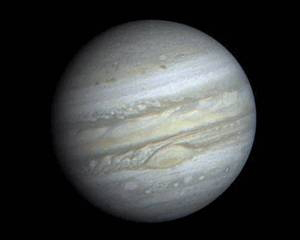
The large and brilliant star like object rising low in the southeast every evening after sunset is the mighty planet Jupiter. Due to its prominence in the sky, the Romans named the planet for their chief god, Jupiter.
Jupiter is the fifth planet from the Sun and is the largest one in our solar system. Jupiter is the fourth brightest object in the sky, after the Sun, Moon, and Venus. If it were hollow, more than 1,000 Earths could fit inside. It also contains more matter than all of the other planets combined.
Jupiter is a gas planet composed of about 90% hydrogen and 10% helium and it shines with reflected sunlight. It does not have a solid surface; the gaseous material simply gets denser with depth.
Jupiter is a stormy place all over, not just in certain “spots.” High winds and lightning are a regular feature in its cloud cover, along with auroras that light up the Polar Regions just as they do on Earth. Powerful winds dominate the atmosphere with crisscrossing jet streams, lightning and huge hurricane-like storms like the Great Red Spot. This storm has been raging for over 300 years and is about 2 Earth diameters wide. More recently, Jupiter has acquired a feature known as Red Spot Jr., a storm about half the size as the original and located in the same hemisphere. The light-colored bands in Jupiter’s clouds are called zones, and the dark-colored bands are called belts.
It takes Jupiter 12 years to orbit the Sun, which conveniently places the planet in a different zodiacal constellation each year. This year it

shines in front of the constellation Capricornus the Seagoat. Strangely though, Jupiter’s day is the shortest of any planet in the solar system at 10 hours.
On average, Jupiter is 779 million kilometers (486 million miles) away from the Sun while Earth is only 150 million kilometers (93 million miles) away. Jupiter is now about 32 light-minutes from Earth while our Sun is much closer at only 8 light-minutes away.
The planet has 63 known moons and a slight ring of smoke-sized particles and dust. The most famous moons are Io, Callisto, Europa and Ganymede. Galileo first observed these in 1610. These moons can be seen as tiny points of light through a small telescope and even binoculars – if you steady them.
So check this wonderful planet out. Jupiter reaches opposition, its point closest to earth, on August 14, 2009. Around that time, Jupiter will appear opposite the sun in our sky and that means it will be visible all night long. This will be Jupiter’s brightest, biggest and closest approach to Earth since the century began!
Clear Skies!



